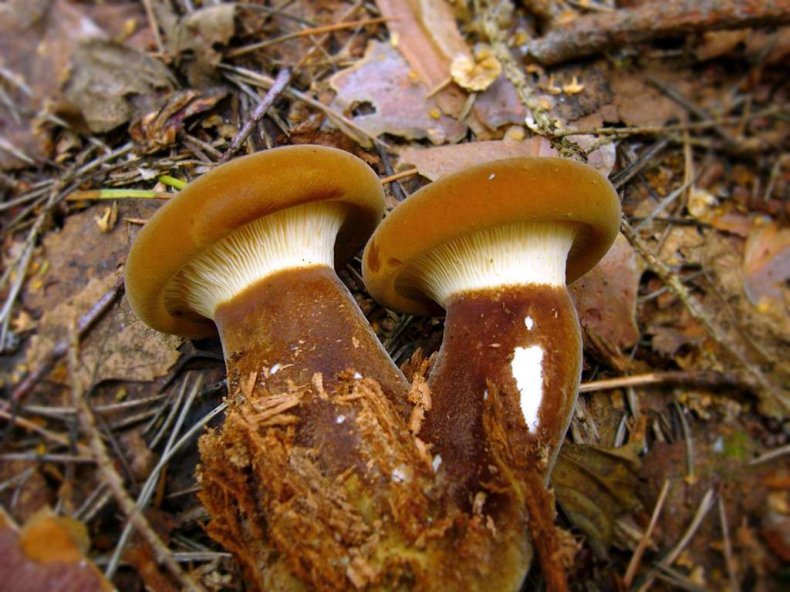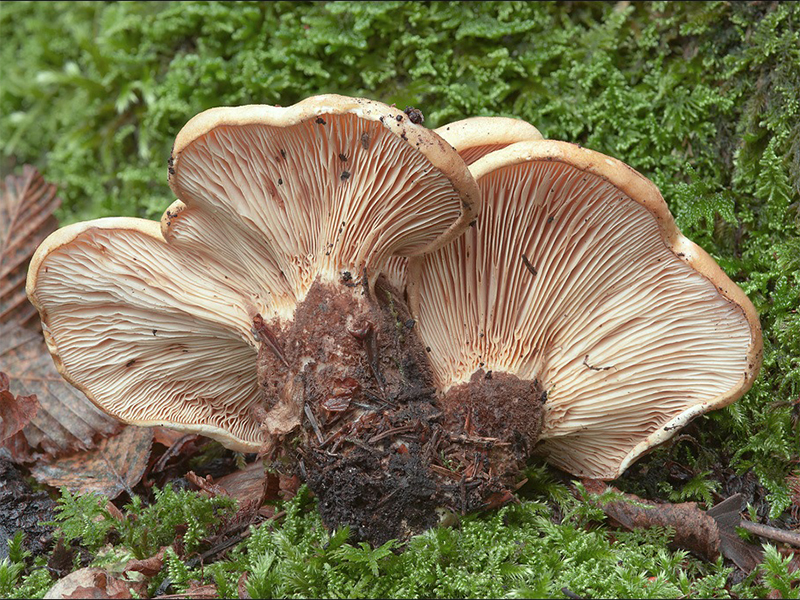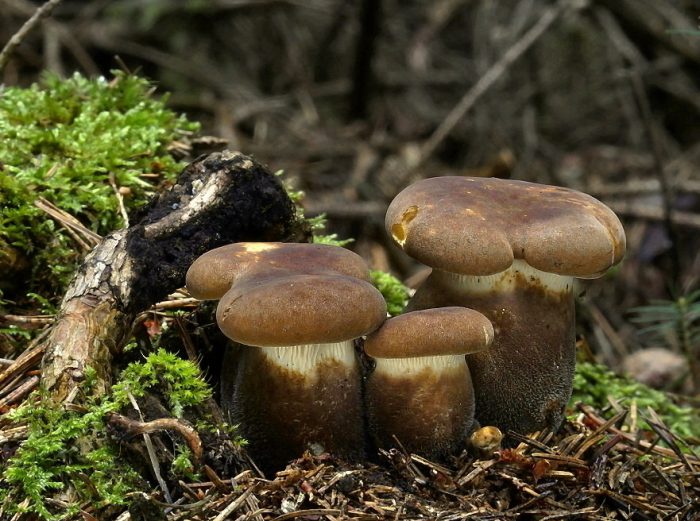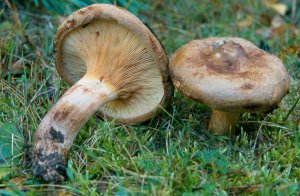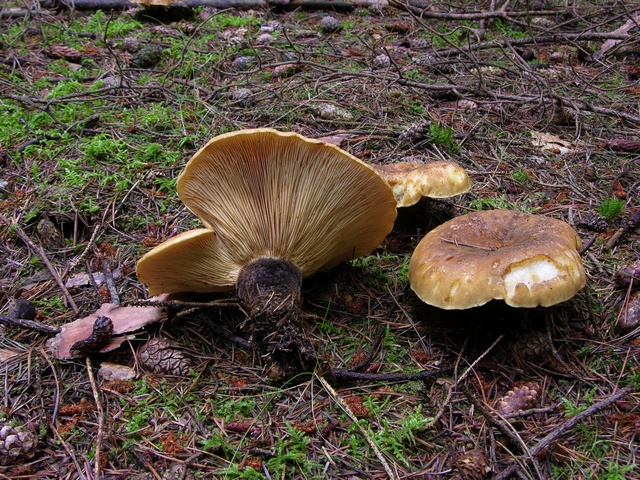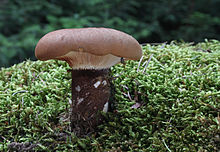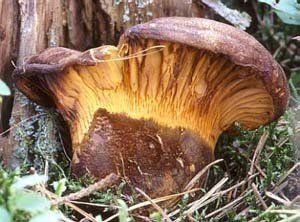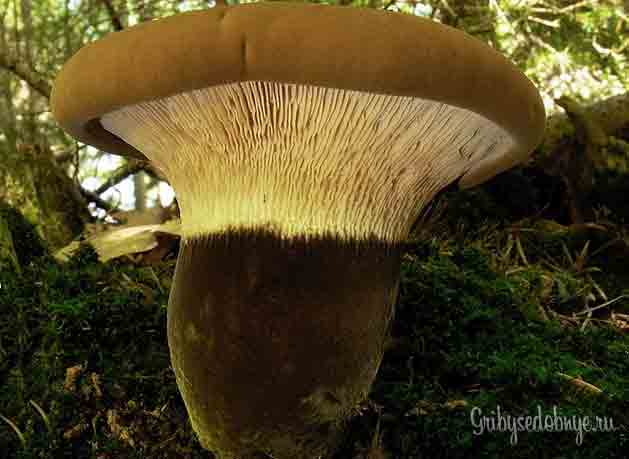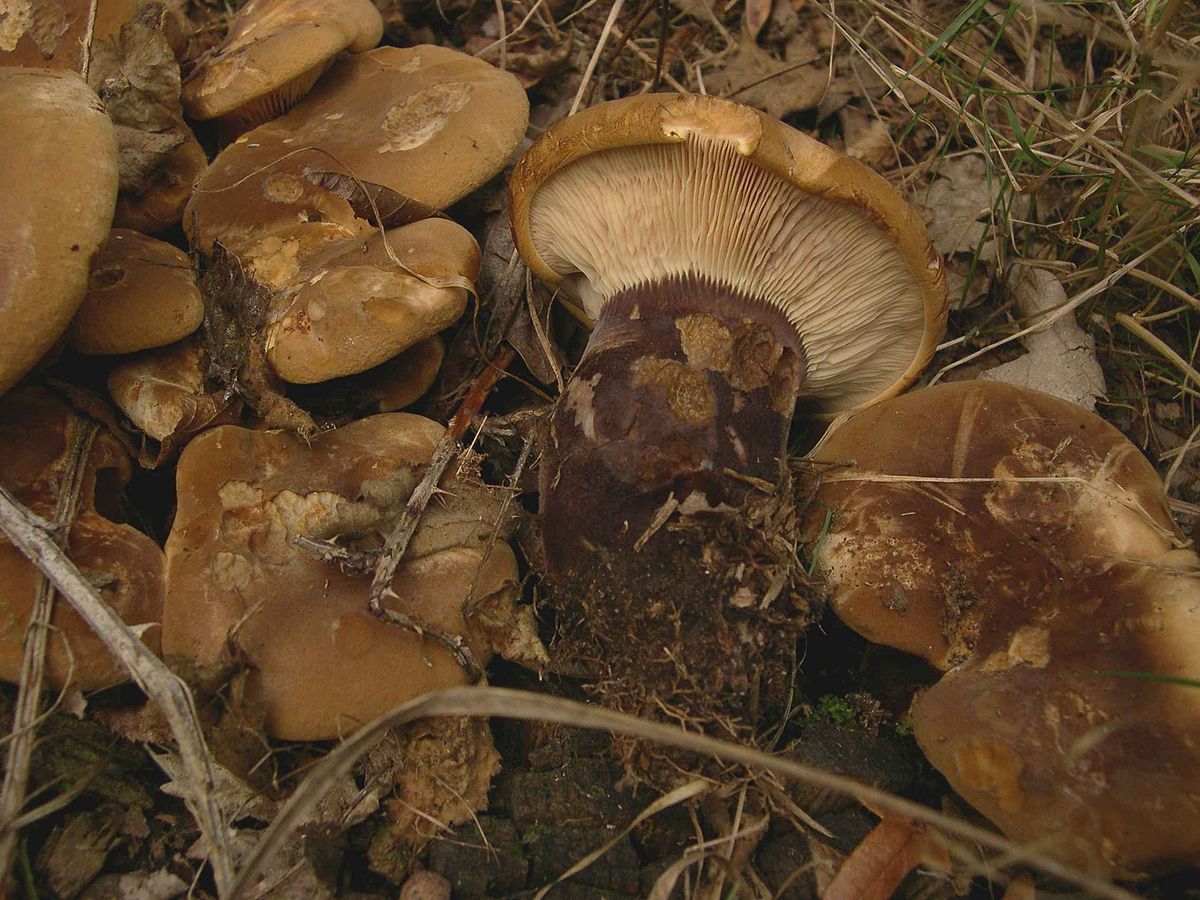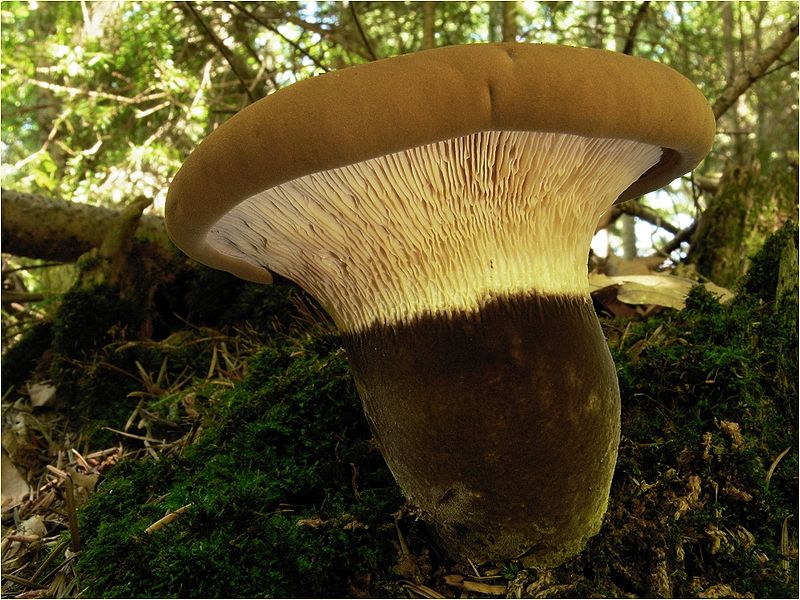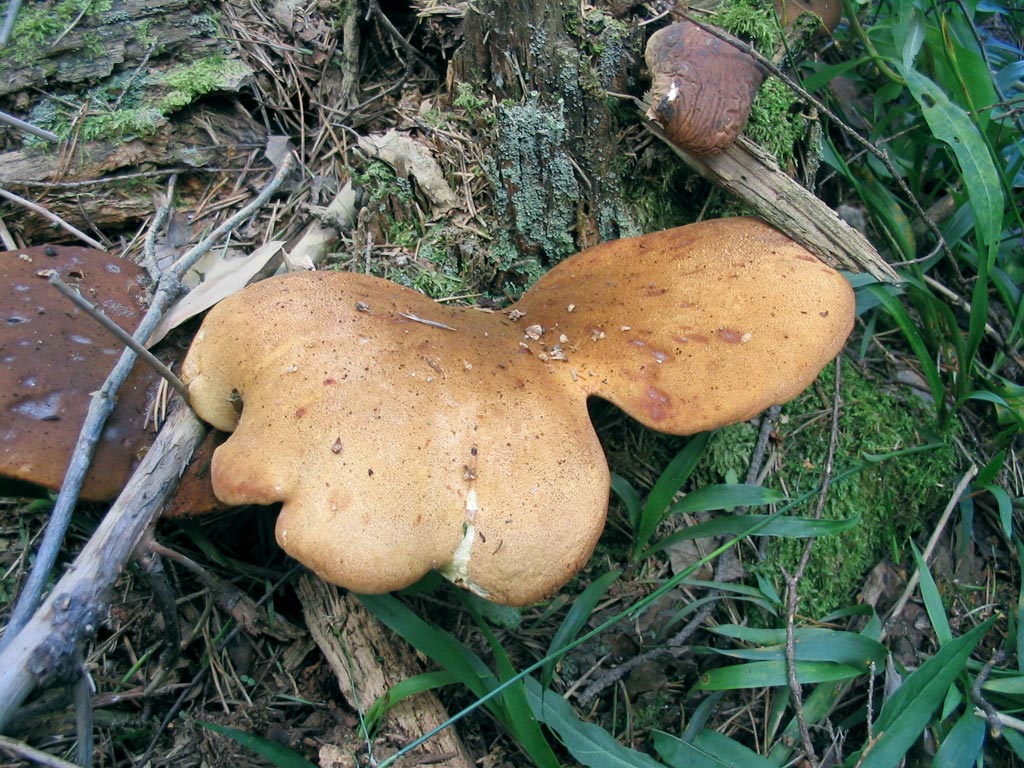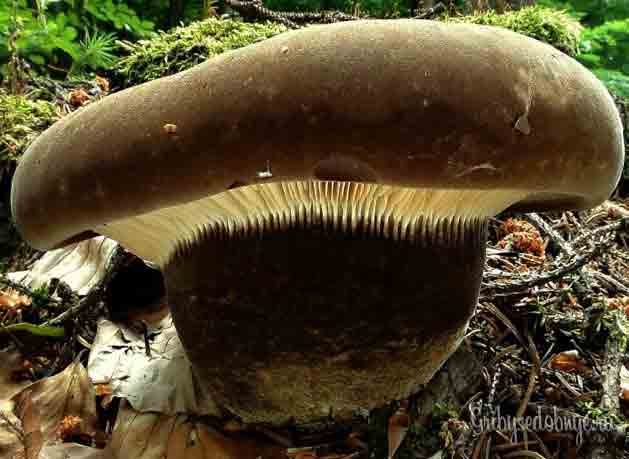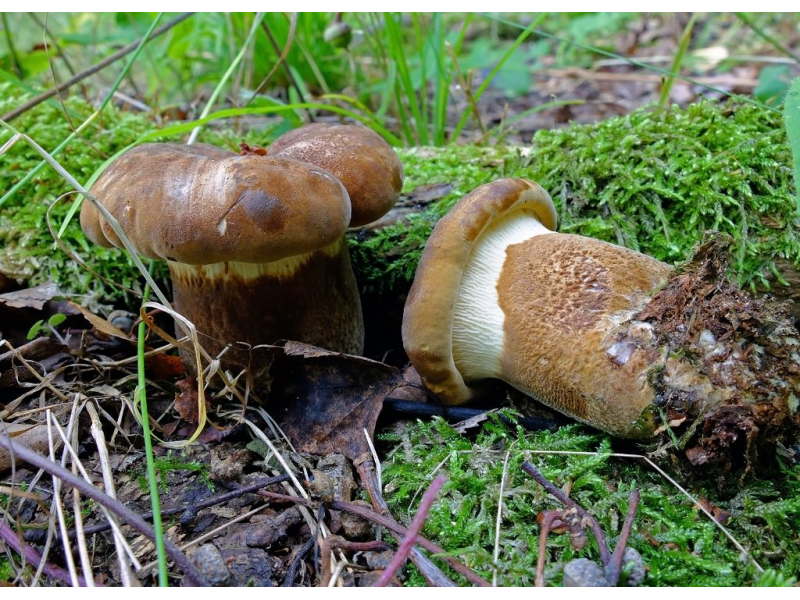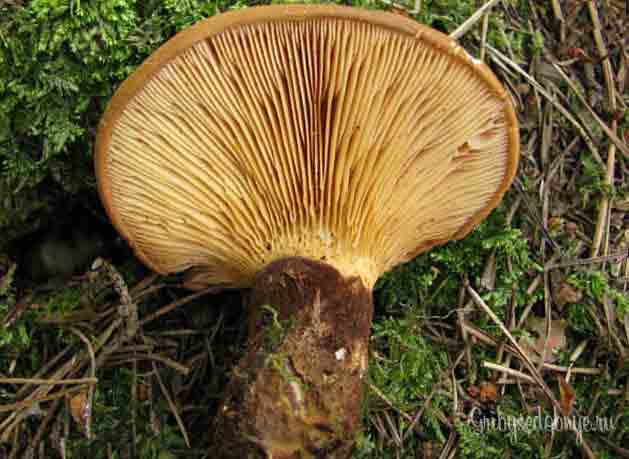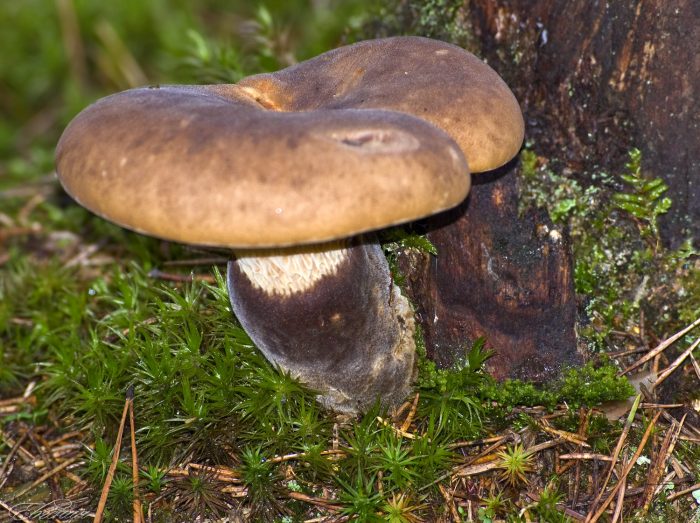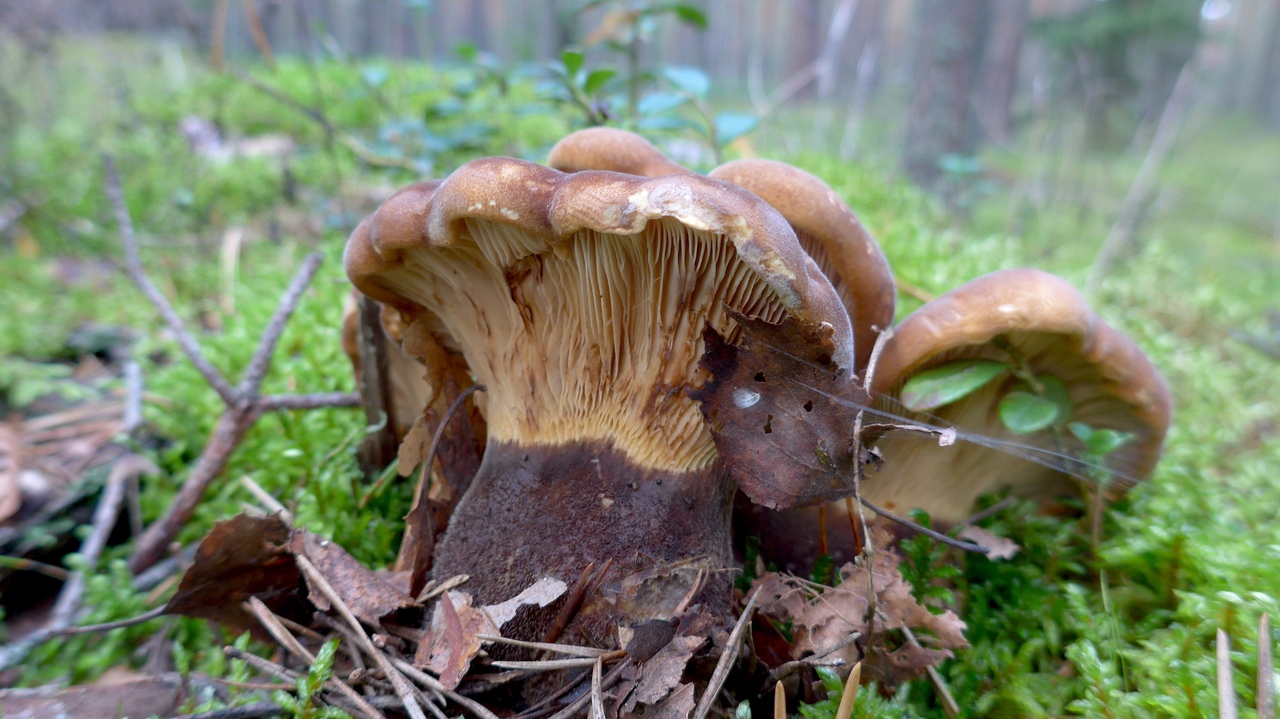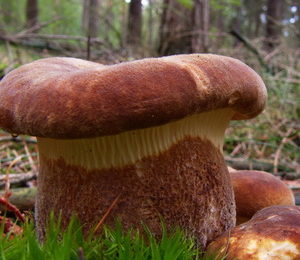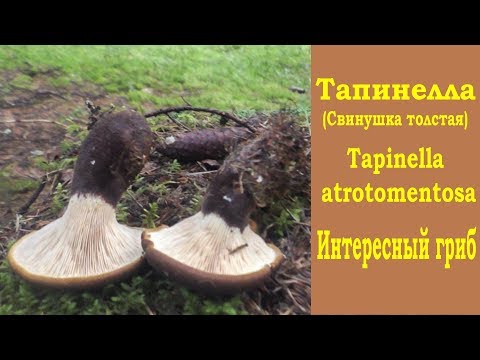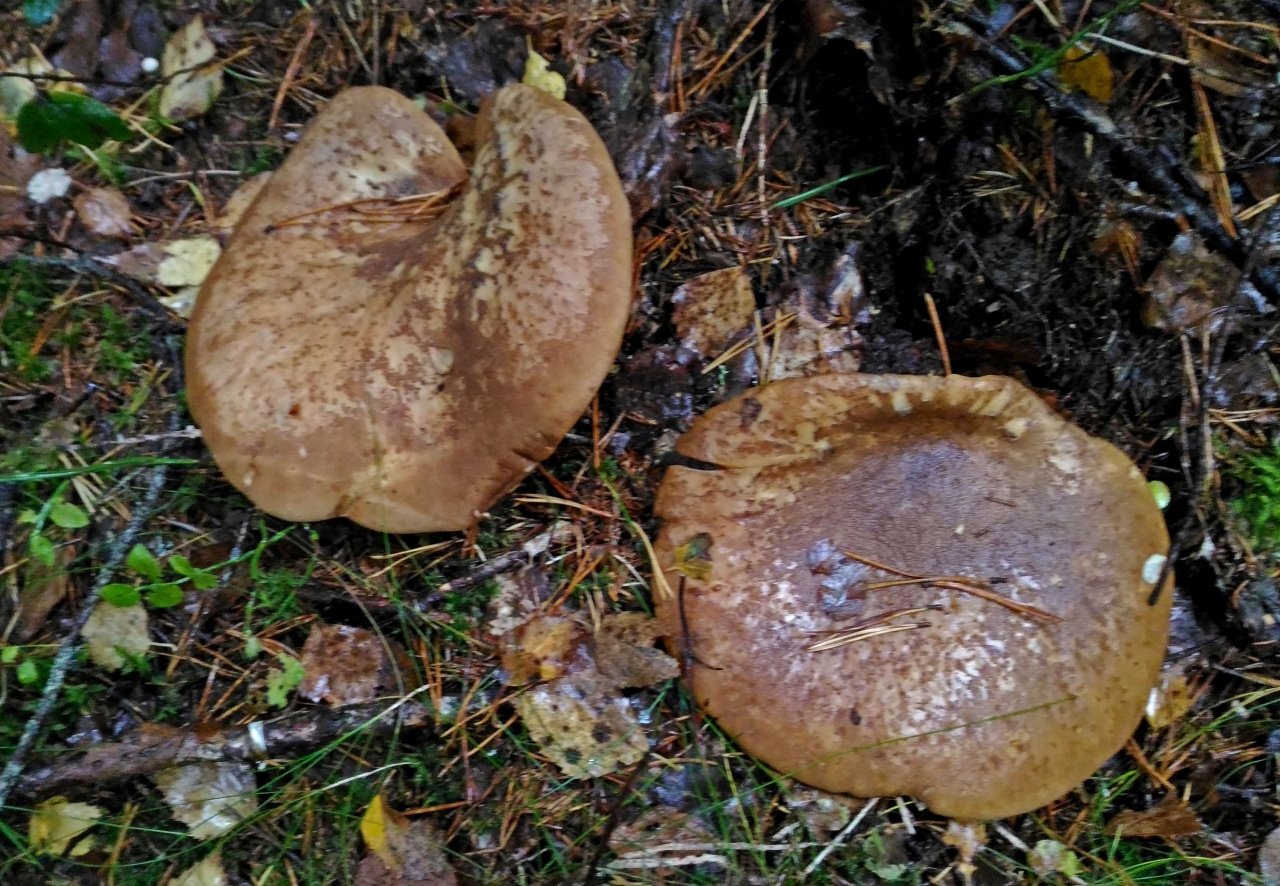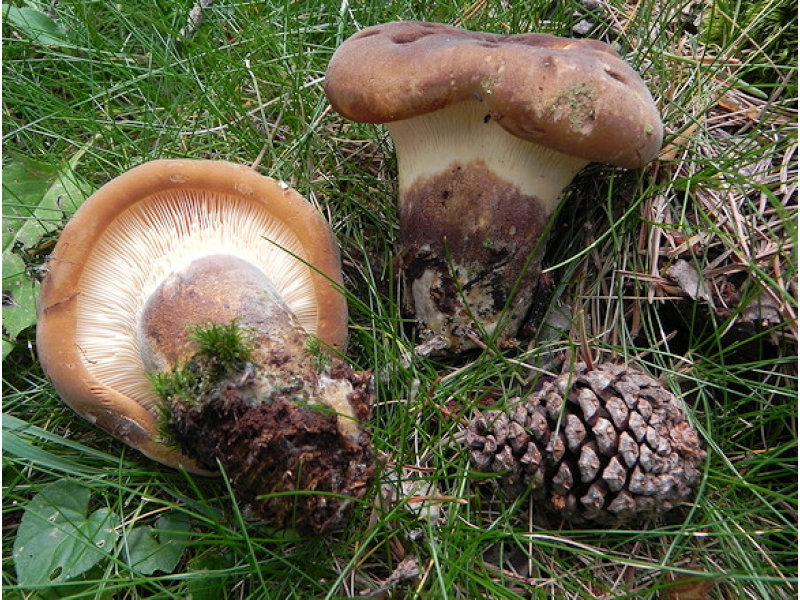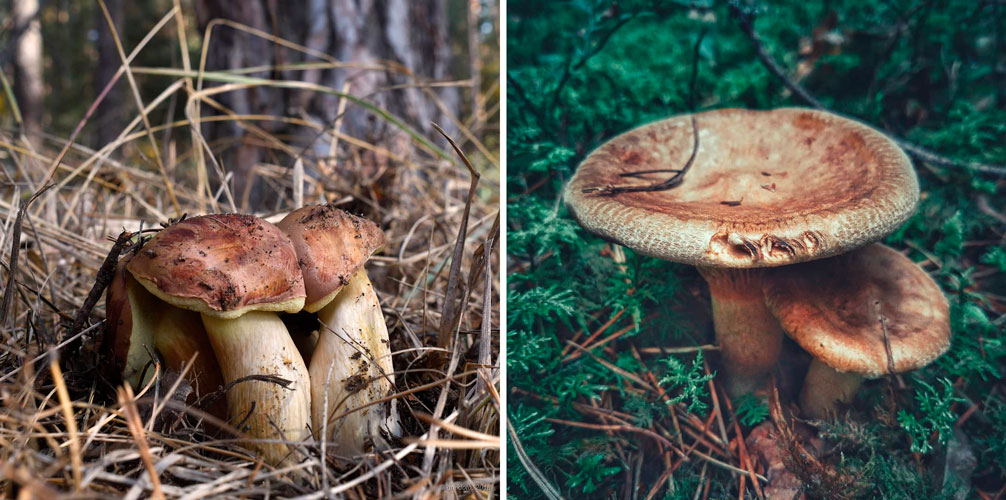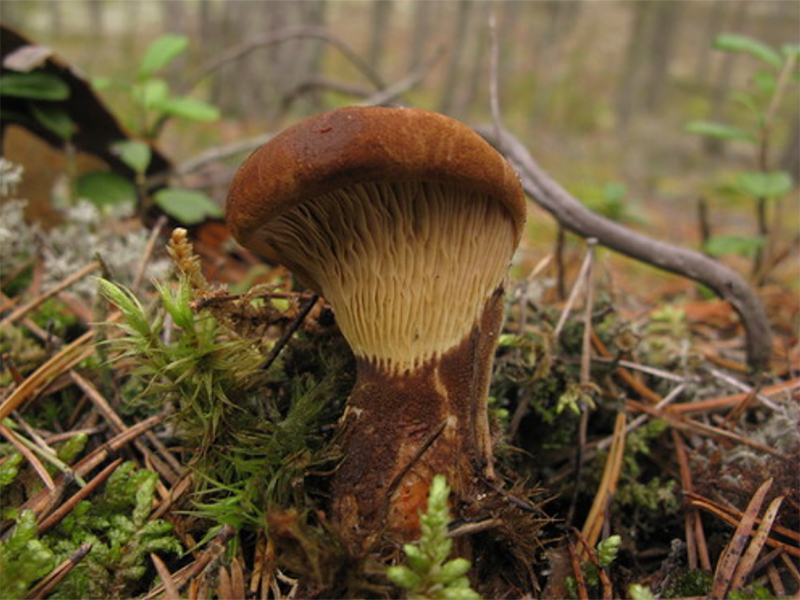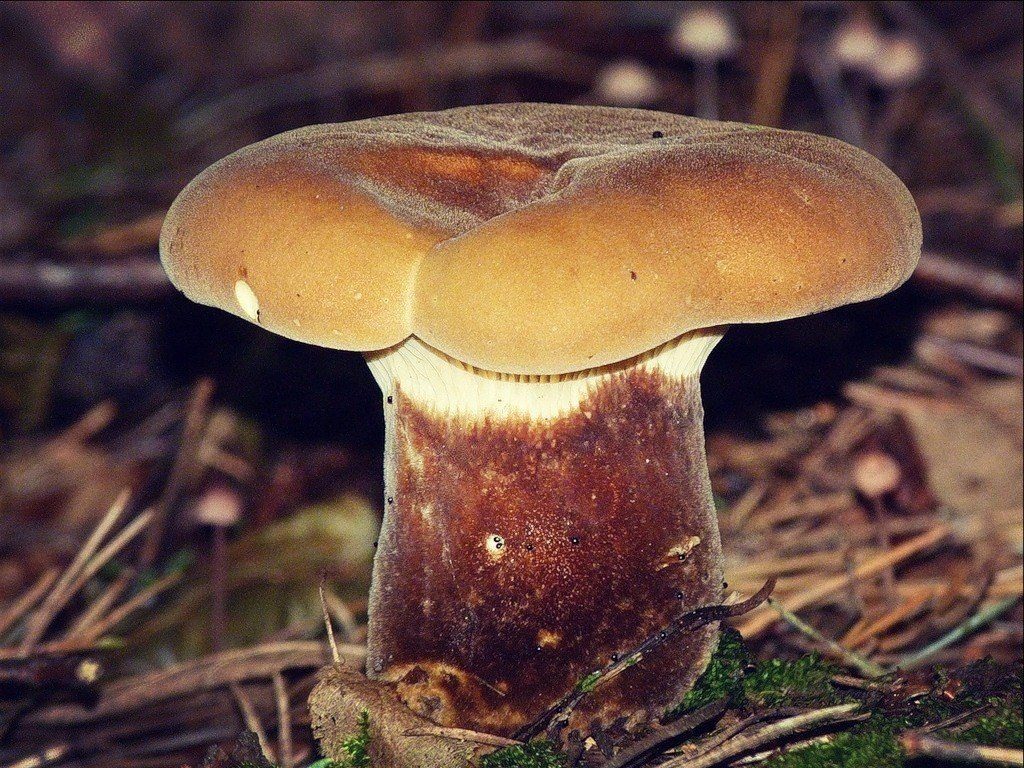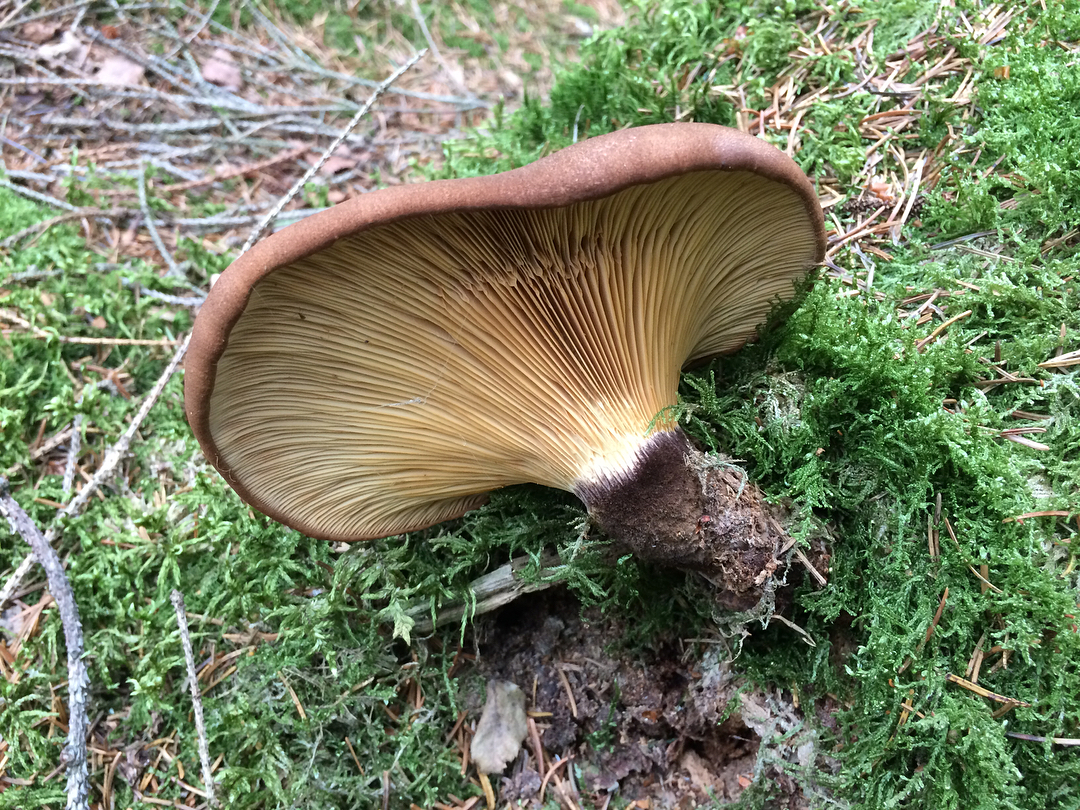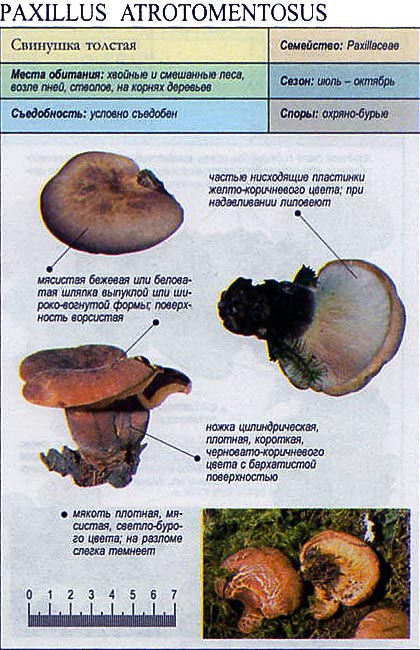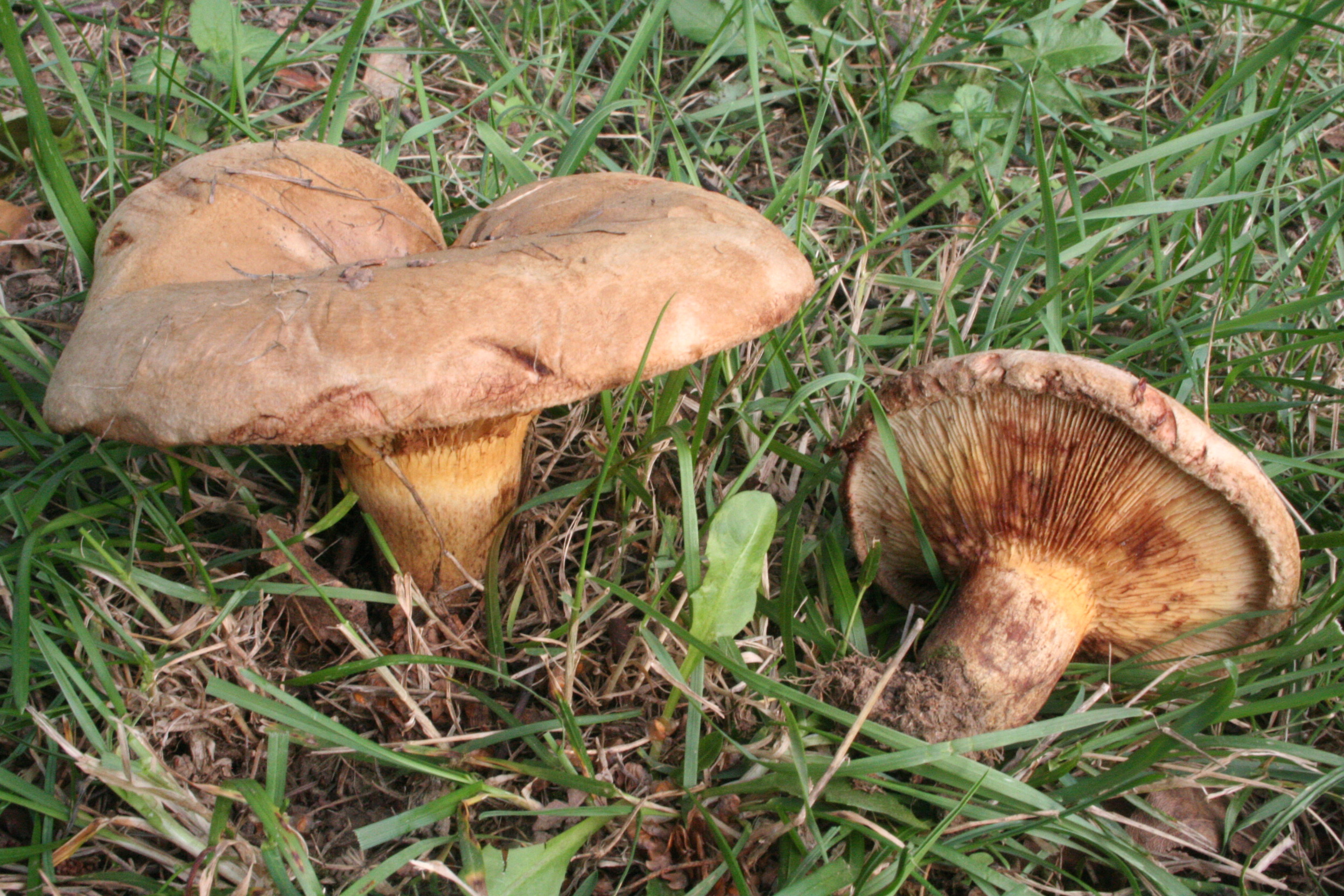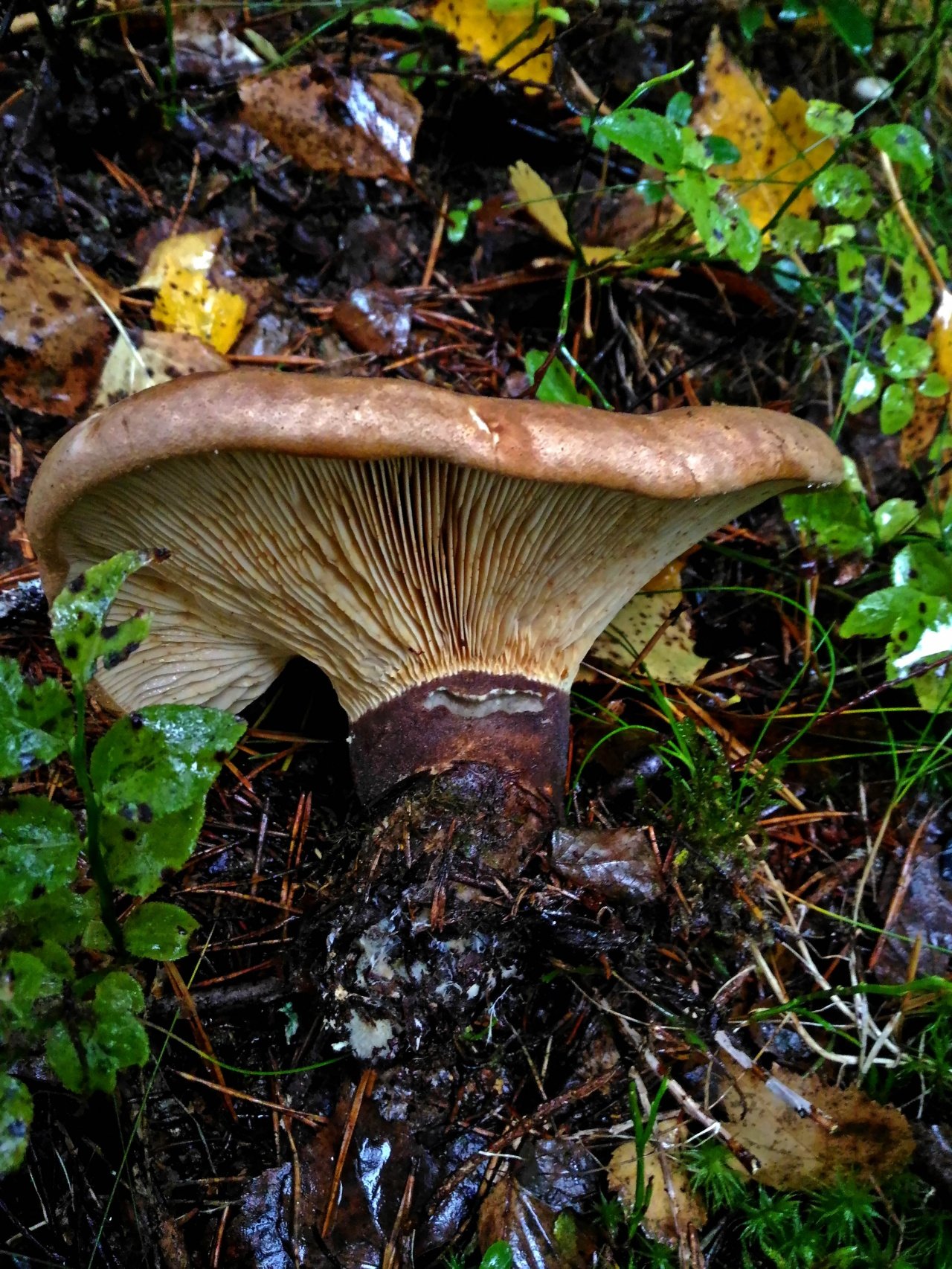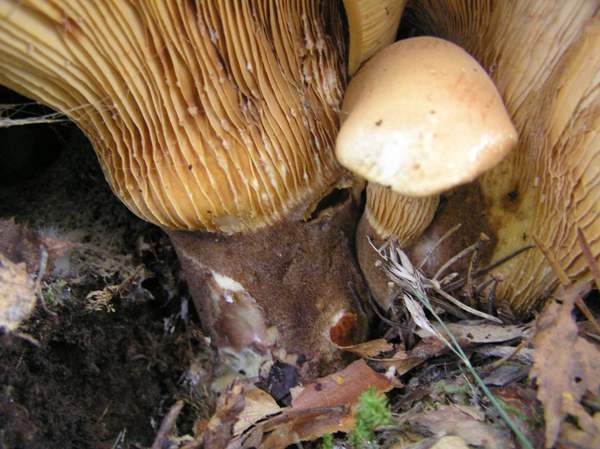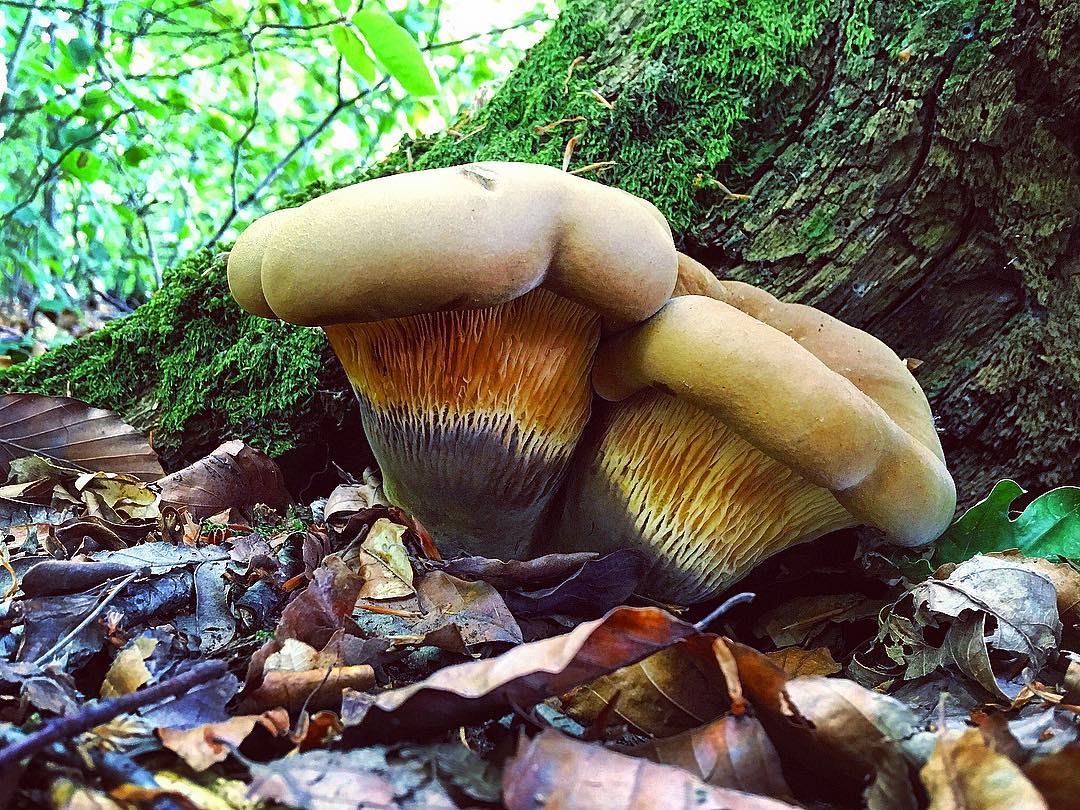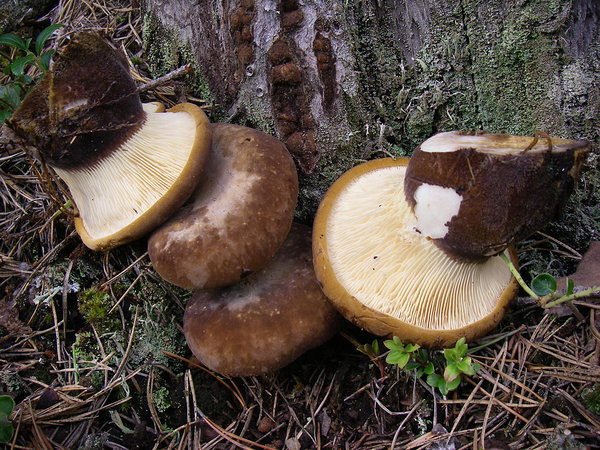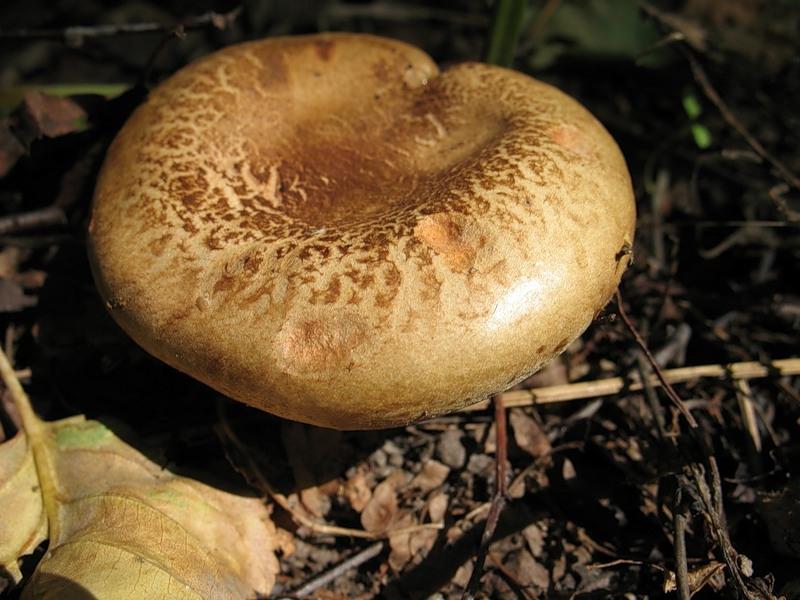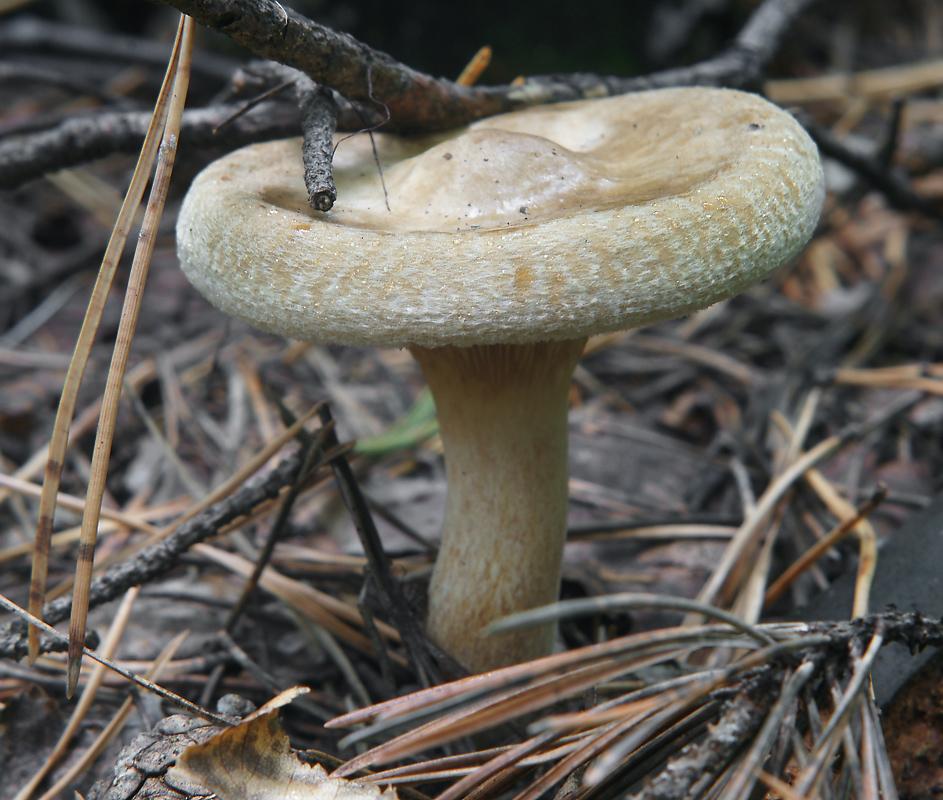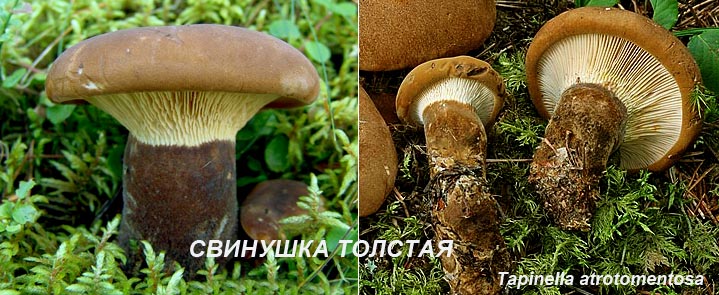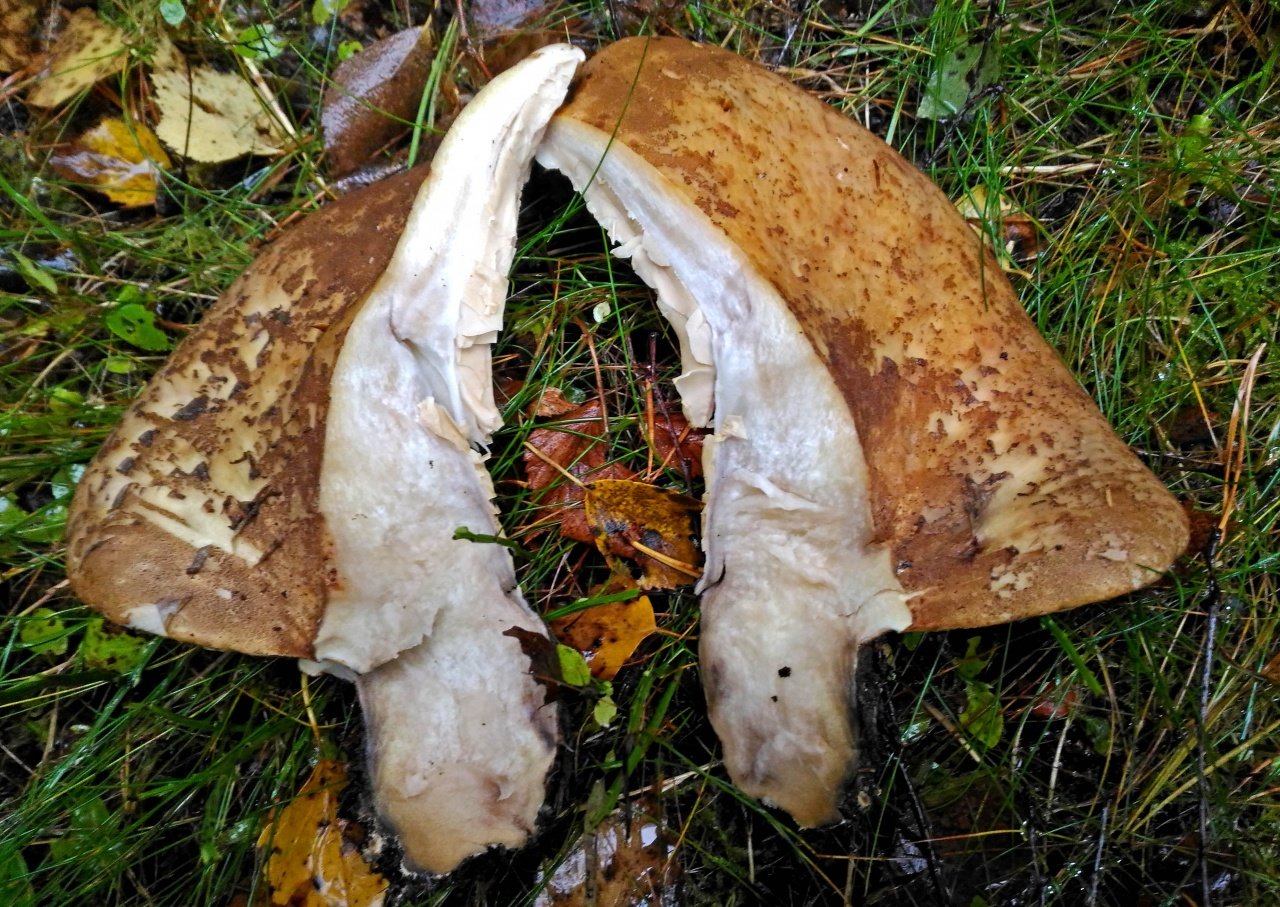Poisonous and inedible pig species
Slender pig (Paxillus involutus)

Poisonous mushroom.
The diameter of the cap is 12-15 cm. The structure is fleshy, the shape of young mushrooms is slightly convex, the edge is felt, turned down, later it becomes flat, funnel-shaped, depressed in the center, sometimes funnel-shaped. The edge is wrapped at the bottom, crimped, ribbed or wavy. The cap color of the young mushroom is olive-brown; in mature specimens it varies from gray-brown to rusty-brown. On the cut and in case of pressure, the cap darkens. The surface of the cap is dry, pubescent in young mushrooms and smooth in mature ones; in wet weather, the cap becomes shiny and sticky. The pulp is dense, soft, loose in old mushrooms. The color changes from light yellow to brown or yellow-brown, the flesh darkens on the cut. In dry weather it quickly becomes wormy. The taste and smell are not expressed. The leg is solid, short, about 9 cm high, 2 cm thick. The surface is matte, smooth, ocher-olive or dirty yellow, lighter than the cap, or matches it in color.
Grows in groups or singly in different forests, in humid, shaded places, rarely on tree trunks. Mass fruiting occurs from June to October.
Alder pig (Paxillus filamentosus)
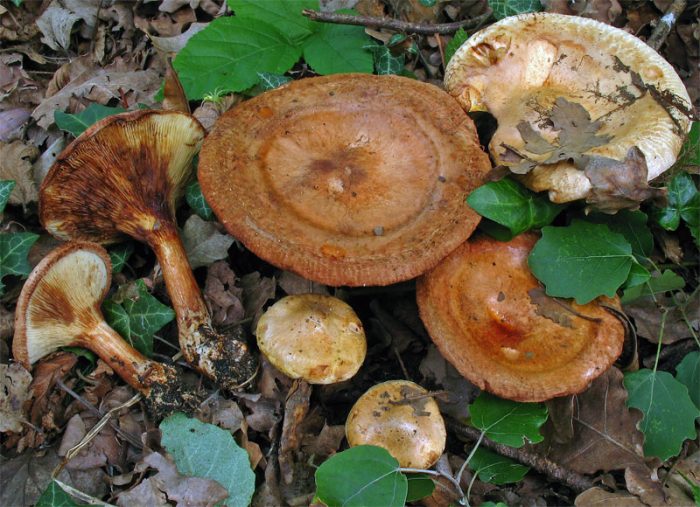
Poisonous mushroom.
The alder or aspen pig is a rare species. Outwardly, it resembles a thin pig, but the cap of this mushroom is distinguished by a scaly-cracking surface painted in a yellowish-red hue. Grows according to the name in deciduous and mixed forests under alders and aspens.
Pig ear or tapinella panus (Tapinella panuoides)
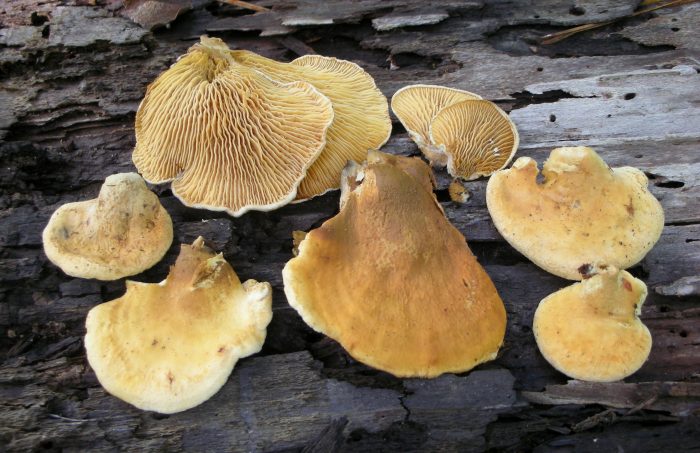
Poisonous mushroom.
A lamellar mushroom, the body of which is characterized by lateral attachment of lozenge-shaped caps (diameter about 16 cm), fused or single, on a short stalk of thickened mycelium. The surface of the cap in young mushrooms is felt, gradually becoming smooth, the color is from yellowish-cream to brownish-purple. The edge is thin, wavy, folded down. On the bottom of the cap there are narrow yellowish-cream or orange plates. The base of the mushroom is dense, velvety, brown. The pulp is fleshy, light brown, after drying it becomes spongy.
The fruiting season begins in late summer and lasts until late autumn. Grows singly or in groups, on stumps or conifers. Sometimes the fungus settles on the surfaces of old wooden buildings and destroys them.
The fat pig is rarely confused with other types of mushrooms, since it is distinguished by its beautiful velvety leg. The appearance of the thick pig's cap is similar to the Polish mushroom (Boletus badius) and the green moss (Xerocomus subtomentosus). But both of these tubular mushrooms are edible.
Description of species
There are several types of pigs. Some of them are uniquely poisonous, others can be edible with some heat treatment.
Fat pig
Until recently, this particular variety was considered fit for human consumption. The only way to cook a felted pig is to pickle or pickle it. In any other form, the flesh is too tough.
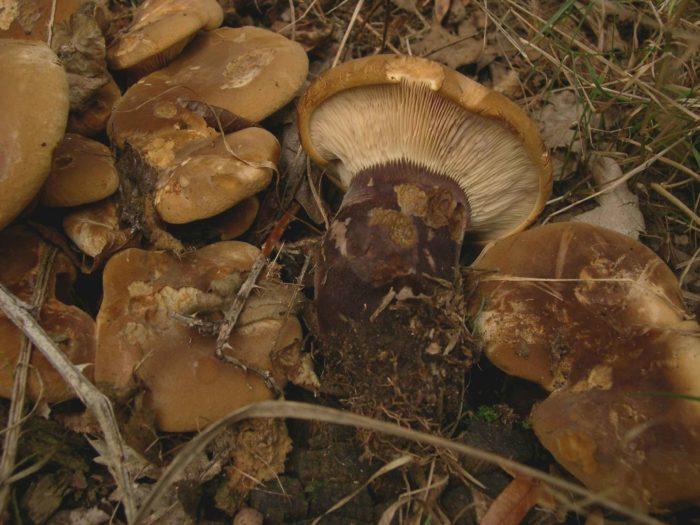
Outwardly, the mushroom looks like this:
- the cap is large, up to 20 cm in diameter. The edges fold inward;
- in young specimens, the cap has a regular rounded shape, but becomes disproportionate with age;
- the skin is velvety, brown or olive brown;
- the pulp is watery, yellowish, does not have a pronounced odor;
- the leg is short, brown or olive;
- light yellow plates are located under the cap. They turn brown when pressed.
In the past, some felt pigs were eaten.Some mushroom pickers still believe that young specimens can be cooked: salted and canned. But even if you peel the mushrooms, wash off all the debris from their surface and boil them, the pulp will remain bitter and potentially harmful to health.
The pig is thin
Another questionable variety. The ripening season for fruit bodies occurs at the end of summer and autumn. Found in coniferous and deciduous forests.
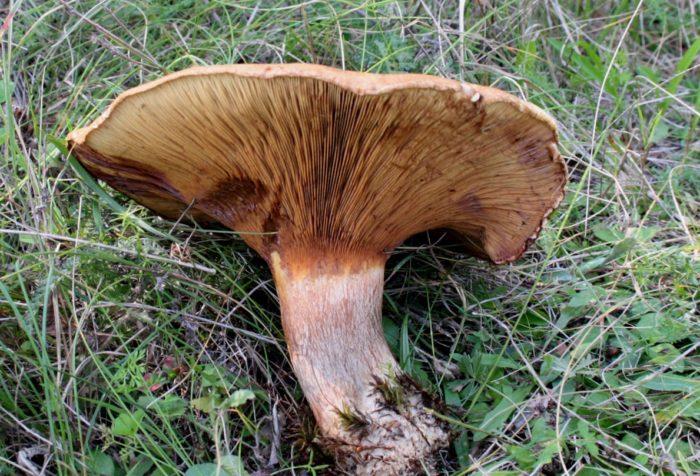
The external differences of the mushroom are as follows:
- the cap is olive-brown (in young mushrooms) and rusty-brown with a gray bloom in old ones. Diameter from 12 to 20 cm;
- the pulp is dense, pale yellow, becomes loose with age;
- the leg is cylindrical, no more than 6 cm in height;
- there are wide and sparse plates under the cap.
Pig ear-shaped (panus-shaped)
This mushroom is dangerous because it is poisonous and looks like edible oyster mushrooms.
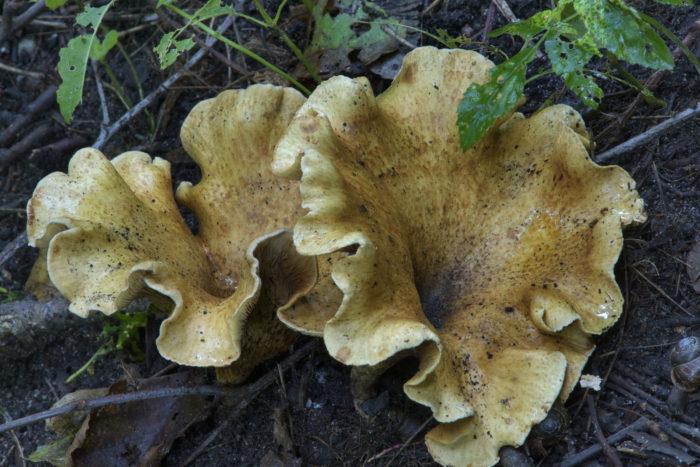
The ear-shaped pig has the following features:
- grows on dead coniferous trees, sometimes it can grow on wood chips;
- the shape of the cap resembles a fan, it is painted brown or orange;
- there is no leg, and its role is played by a short lateral process.
The pig of this variety has a well-pronounced mushroom smell, but it cannot be eaten due to the threat of poisoning.
Other types
There are several more poisonous varieties in the pig family:
- Alder: got its name due to the fact that it grows on the trunks of alder and aspen. The hat has the shape of a concave funnel and is colored yellow or brownish. The pulp is dense, yellowish, without a pronounced smell and taste.
- Pig Paxillus obscurisporus: occurs in clearings, forest edges and pastures from early spring to the first autumn frost. The hat is golden brown with a raised edge. The leg is no more than 8 cm in height, gray or yellowish. Has a pleasant mushroom smell, but is not suitable for human consumption.
Description of the appearance of the mushroom
The genus Svinushka combines the types of hat-footed structure. However, in some of them, the stem can be reduced, as a result of which the caps sit directly on the substrate. Legs are central or eccentric. The plates are descending, at the leg connecting (anastomosing), easily separated from the cap. The edge of the cap is often wrapped, especially in young specimens. Spores are smooth, brown, buffy or dirty yellow.
A fat pig is a mushroom with a large brown or dark red cap, the diameter of which, although it normally fluctuates within 12-20 cm, can reach, although in rare cases, 30 cm.The surface is rough, felt, with a slight velvety. In the process of development, the cap becomes dry and bare, small cracks form on it. The young mushroom is characterized by a round shape of the cap, which changes with growth and becomes disproportionate with wavy edges. The plates of the hymenophore are yellow, descending, branched and connected at the base (at the leg).
The fat pig has a massive and dense leg, the height of which does not exceed 10 cm. Its surface is covered with a velvet, felt bloom. The species is characterized by the fact that the leg does not melt from the center of the cap, but is shifted to its edge. This type of cap is called "side".
The thick pig mushroom pulp does not have an expressive smell, and also has a bitter and tart aftertaste. There is a lot of yellow liquid inside.
Irina Selyutina (Biologist):
Specific features of the thick pig:
- Upon contact of the cap and leg with ammonia (NH3H2O or NH4OH), their surface is painted in a bright lilac color.
- When a solution of caustic potassium or potassium hydroxide (KOH) is applied to the pulp, it turns green-black.
- The pulp is hygrophilous, as a result of which liquid accumulates in it.
- The fruiting bodies contain:
- atromentin: a brown pigment with antibiotic properties;
- telephoric acid: a blue pigment that can be used to dye wool products (or wool itself) bluish.
The fungus grows near the trunks, stumps and roots of conifers (pine) and deciduous trees. The fruiting period lasts from mid-July to early October. Dwells in small groups.
Differences from similar varieties
The main distinguishing feature of Fat Pig is velvety on the leg. The hat has a similar description to the Polish mushroom or the green moss mushroom, but these mushrooms belong to the tubular group and are edible.
Differences between a fat pig and a thin one:
- Climate: Fat pig is common only in temperate climates.
- Place of growth: the fat pig grows only near trees or stumps.
- Fruiting period: The slender pig begins to bear fruit in mid-May.
- Stem shape: a thin pig is characterized by a cylindrical stem shape.
- Size: the diameter of the leg of a thin pig does not exceed 3-4 cm, and the height is 8 cm.
Could there be mushroom poisoning by pigs?
The fungus is conditionally poisonous, and it is not recommended to eat it. There are cases of fatal mushroom poisoning by pigs. Basically, this happens if they eat not young, but old mushrooms with huge caps. Many scientists note that muscarine, which is found in amanita and pigs, even if boiled for 3 hours, remains in the product and can cause serious poisoning. And after three hours of processing, the mushrooms turn into mucus and become inedible.
Therefore, before consuming and preparing these mushrooms, think a hundred times. Scientists have proven that pig mushrooms also accumulate heavy metals, which can subsequently cause serious toxic poisoning, as well as disruptions in the work of many internal organs.

Insidious mushrooms
Your health is in your hands. Do not risk it, because you can find a huge amount of edible mushrooms on the shelves. Instead of pigs, you can pick healthier mushrooms such as chanterelles and boletus mushrooms.
The pig is thin: photo and description
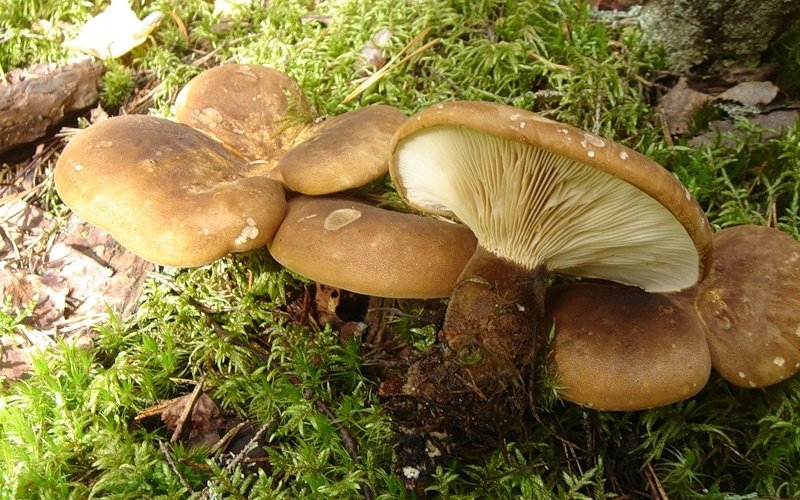
Pig mushroom in the photo
Pig is a lamellar mushroom that grows in various types of forests in large groups, from July to October, it can form mycorrhiza. In recent years, the pig has been classified as a poisonous mushroom (it can cause poisoning, even fatal). It contains substances that lead to a decrease in red blood cells in the blood.
Previously, the pig was considered an edible mushroom, it was even taken into government procurements. In all the old books, it is designated as an edible mushroom. Currently, views on her have changed. It turned out that the pig contains an antigen that causes the production of antibodies by the human immune system. Moreover, the effect of this antigen on the body depends on the susceptibility of each person.
For some, excessive antibody production may occur, resulting in allergic shock. Signs of poisoning may appear after a few hours or several years, since the toxin can accumulate in the body. Kidney function is impaired, which can lead to death. Treatment is to maintain kidney function.
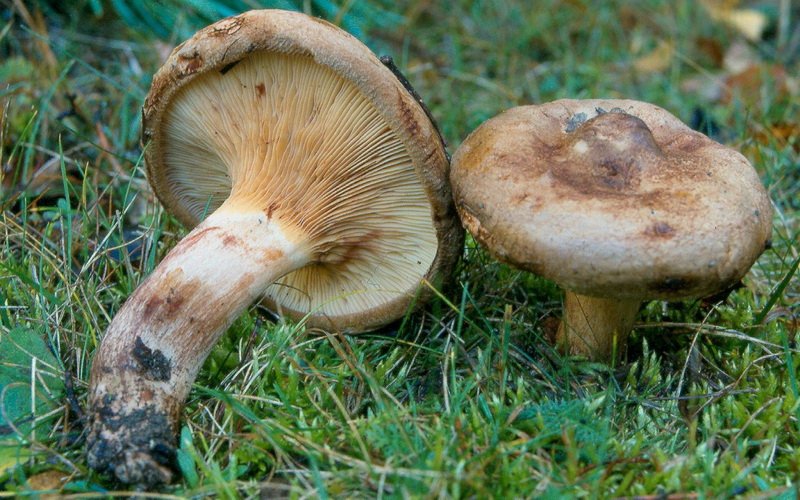
The pig is thin in the photo
Favorite habitats are wet areas of soil in lowlands and near swamps, woodlands, parks, vegetable gardens, as well as fallen tree trunks.
The mushroom is considered poisonous.
The cap is 5-15 cm in diameter, in young specimens it is convex, fleshy, light olive or greenish-beige, with a strongly tucked edge, with dense, thick light pulp, then open, with a depressed center, yellow-brown or gray-brown ...
The plates are descending, soft, branched, yellow-buffy.
The pulp is thick, soft, elastic in young mushrooms, loose, pale brown in mature ones, brown in old mushrooms, darkens on the cut. The smell of the pulp is pleasant, the taste is sour.
Fruiting from July to November.
According to the description, this pig cannot be confused with other mushrooms.
Fat pig (Paxillus atrotomentosus), or black pig, is a rare lamellar mushroom that grows singly and in small groups from mid-July to early November on the trunks, roots and deadwood of coniferous and deciduous trees.
The fat pig mushroom is conditionally edible.
The leg is very thick, densely velvety, black, whitish-yellowish under the cap, 3-9 cm long, 2-5 cm thick.
The pulp is dense, fleshy, light brown in color, darkens on the cut, elastic, with a pleasant mushroom aroma and a bitter taste. It turns brown quickly when exposed to air.
Fruiting from August to November.
Like the thin one, this pig cannot be confused with other mushrooms according to the description.
The mushroom is not tasty, but after boiling it can be used in a mixture with other mushrooms. The fat pig belongs to the fourth category of mushrooms. After pre-boiling, it can be boiled, fried and marinated.
Mushroom harm
All pigs are definitely not valuable mushrooms. Health damage can be caused by the use of even conditionally edible fat pig, if it is often eaten in large portions.
Poisonous properties
A pig contains substances that affect the functioning of a living organism - lectins. They do not die during heat treatment. When passing through the digestive system, they enter the blood cells and disperse throughout the body, causing an allergic reaction at first. But the antibodies that have come to the defense do not attack the lectins themselves, but the cells in which they are located. That is, the action of the organism is directed against the organism itself.
And the next insidious step of poisons is kidney damage, the appearance of renal failure. In addition to the composition of the mushroom itself, the danger is posed by the property of the pig to accumulate heavy metals from the soil, radioactive compounds, sometimes during research there they found such an amount that exceeded the norm by hundreds of times.
Pig poisoning
Poisoning can occur in the first hours or stretch over time. It depends on the dose of the poison, the frequency of its use, the state of the whole organism, and immunity. The cumulative effect works here. At first, dizziness, change in consciousness, nausea, vomiting, abdominal pain, diarrhea may occur. Next, pallor of the skin is added or, on the contrary, jaundice develops, shock or breathing problems may occur.
First aid
Sometimes the symptoms of pig poisoning do not appear immediately, but even after a few days. In this case, it is not always possible to guess that the reason for their poor health is in them. But in case of mushroom poisoning, self-medication or delay is unacceptable. The first thing to do is go to the hospital urgently.
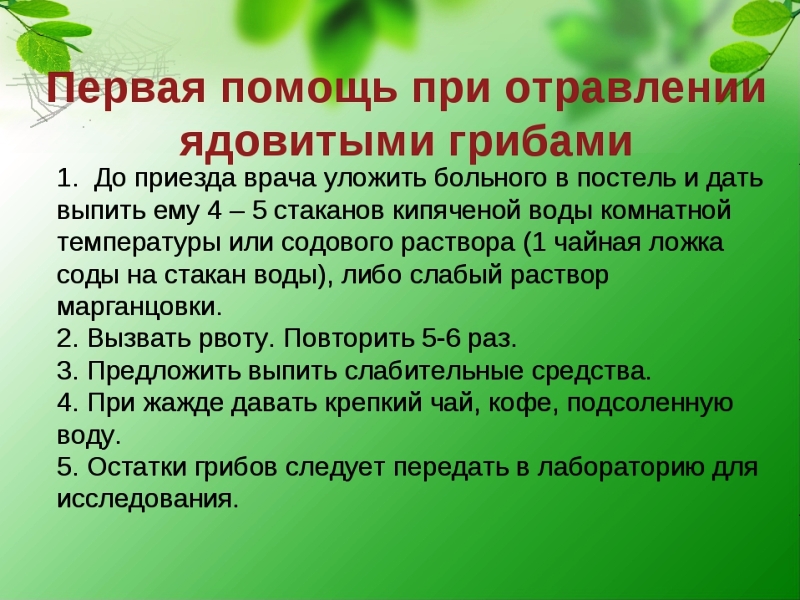 First aid for mushroom poisoning
First aid for mushroom poisoning
There they will do all the necessary laboratory tests and other manipulations (washing the stomach, intestines, administering an antihistamine and more complex resuscitation procedures), the patient will be under the constant supervision of doctors monitoring vital signs. Laboratory tests can show erythropenia, abnormalities in bilirubin and hemoglobin levels.
Unfortunately, today there is no antidote for this type of substance, and treatment is aimed only at reducing symptoms. That is why early medical attention is key.
What a slender pig (Paxillus involutus) looks like
Latin name: Paxillus involutus.
Family: pigs.
Department: basidiomycota.
Class: agaricomycetes.
Synonyms: pig, cow, filly, pig, pig, pig's ear.
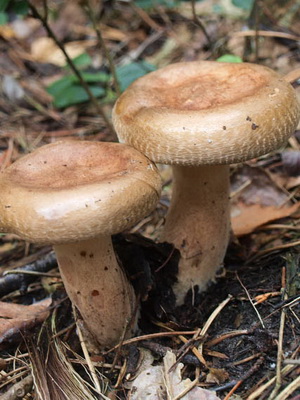
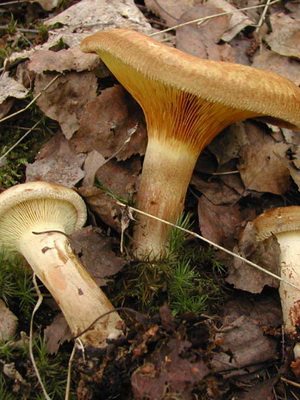
Hat: it reaches sizes from 10 to 20 cm in diameter, but more often the size does not exceed 15-17 cm. Young pigs have a slightly convex cap and curled edges. Middle-aged specimens have a flat and slightly depressed cap that becomes funnel-like at maturity. The color ranges from olive to gray-brown.It becomes sticky and slippery in rainy weather and high humidity.
Plates: as such are absent. The hat has pseudo plates called Hymenophores.


Leg: not more than 10 cm long, about 2 cm in diameter. The surface is smooth, on contact with the skin, a velvety feeling is observed. The color is the same as that of the cap, sometimes a little lighter.
Flesh: firm, thin and soft at a young age, and loose and wormy at maturity. If you break off a piece from the cap, the flesh immediately darkens.
Edible: a poisonous mushroom, when broken in any part of the mushroom, the pulp immediately becomes an unpleasant brown color and the smell of wood appears, more reminiscent of the smell of decay.
Distribution: throughout Russia in mixed, deciduous and coniferous forests, preferring dark, humid areas. Fruiting begins from June to mid-October.
We suggest watching a video showing a slender pig during the mushroom season:
In addition, the most common types of this poisonous fruiting body include not only a thin pig, but also a thick pig. Look at the photo of the difference between a thin and thick pig:
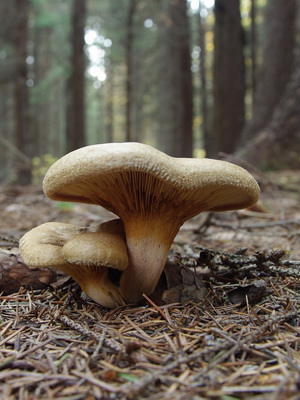
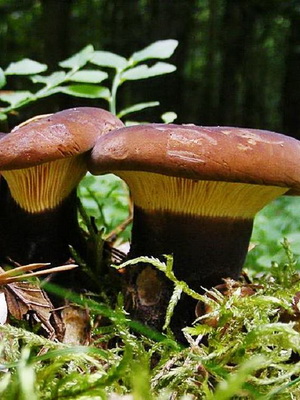
It is worth noting that the plump pig is a rare species of fungus found only in countries with a temperate climate. She chooses the main place for growth in coniferous forests, where there are many trees upturned by the roots, rotten stumps and moss.
The shape of the cap is slightly different from the thin pig and looks more like an elongated tongue. Reaches up to 20 cm in diameter, has a brown or brown color. The surface is velvety, dries up and cracks in adulthood. The leg is short, with a fleecy coating, dense and shifted to the edge of the cap.
These mushrooms begin to bear fruit in early July and grow until the end of autumn, but they are extremely rare. Sometimes they can grow on the ground, on the roots of trees and old stumps in the coniferous forest.
After reading the description of the slender pig and learning what this poisonous mushroom looks like, you will never collect it. Remember that it is capable of synthesizing the dangerous poison muscarine, which is equivalent to the poison of the red fly agaric. In addition, the thin pig accumulates in itself a huge amount of salts of heavy metals, as well as radioactive substances - copper and cesium, which leads to death.
Share article:
How to handle pig mushrooms?
Pigs are more resistant to worms than other fungi (possibly due to their toxicity). Therefore, cleaning them is easy. In no case should you postpone the cleaning and preparation of mushrooms. This is a product that needs to be cleaned immediately, a few hours after collection.
Instructions:
- To do this, you need to cut off the dirt, and soak the mushrooms in cold water for 30 minutes.
- Next, use a knife to scrape off the film and remove the stickiness.
- Soak the mushrooms again for 2 hours in cold water
- After that, it is necessary to boil the pigs for 30 minutes.
- In no case should you use the broth that you received in food
- Because it is in it that toxic substances are located that can cause poisoning
- Pour this broth, and throw the mushrooms in a colander and wait for all the liquid to drain.
- Soak the already boiled pigs in cold water for another 30 minutes
- Only then can you start salting or further heat treatment.
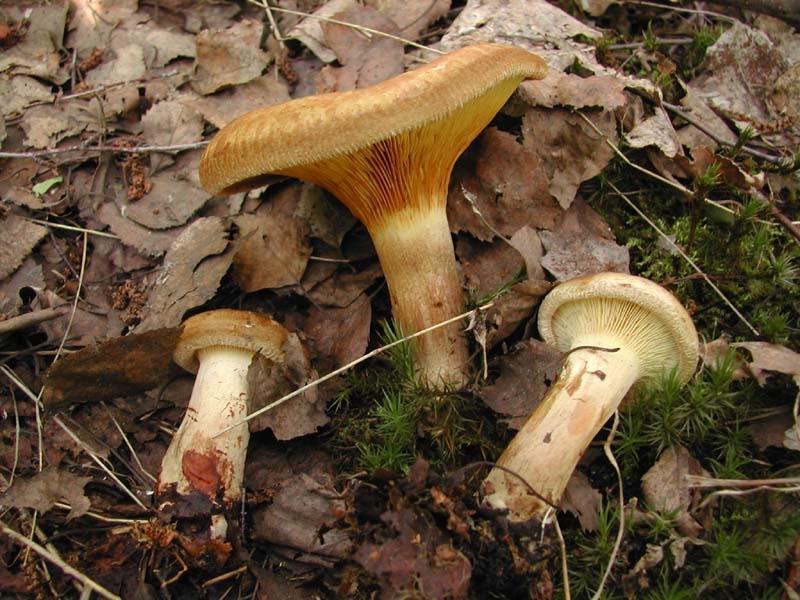
Harvest of bluebirds
The poisonousness of the fat pig
Fat pig is a poisonous mushroom. Previously, it was considered conditionally edible, but cases of its poisoning have been recorded. In addition to the tough and bitter pulp, the fat pig is characterized by the presence of poisonous substances in the composition, which are not destroyed by prolonged exposure to high temperatures. Also, the composition contains heavy metals and copper isotopes, which negatively affect the gastrointestinal tract.
Harmful substances contained in plump pig:
These substances cause severe poisoning.When an antigen enters the body, antibodies are produced, which accumulate in the blood and cause its disease. Lectin and muscarine accumulate in the body, negatively affecting it, and do not come out naturally.
On a note. Back in 1981, the pigs are thick on a par with the village. thin, were excluded from the list of mushrooms allowed for harvesting, processing and sale throughout the USSR.
Poisoning symptoms
- heavy sweating;
- headache;
- nausea;
- feeling weak and tired;
- high salivation;
- lowering blood pressure.
In the absence of first aid, poisoning causes disruption of the gastrointestinal tract. They manifest as loose stools and abdominal pain (cuts). If a large amount of toxic substances enter the body, there is a risk of edema of the brain and lungs.
Symptoms of poisoning do not appear if you eat a small amount of the product. But poisonous substances from mushrooms are gradually deposited in the body and cause permanent harm to internal organs. Lectins help accelerate blood clotting, which causes cardiovascular disease.
Types and their description with photo
The pigs are composed of eight types of mushrooms. Some of them are not very common:
- Ear-shaped. Outwardly, it looks like an oyster mushroom and grows on the trunks of coniferous trees, attaching to them with a leg or an appendage from the cap. The color is olive, yellow or brown, the plates are light. The diameter of the cap is in the range of 2-8 cm. Growing time is late summer and autumn.

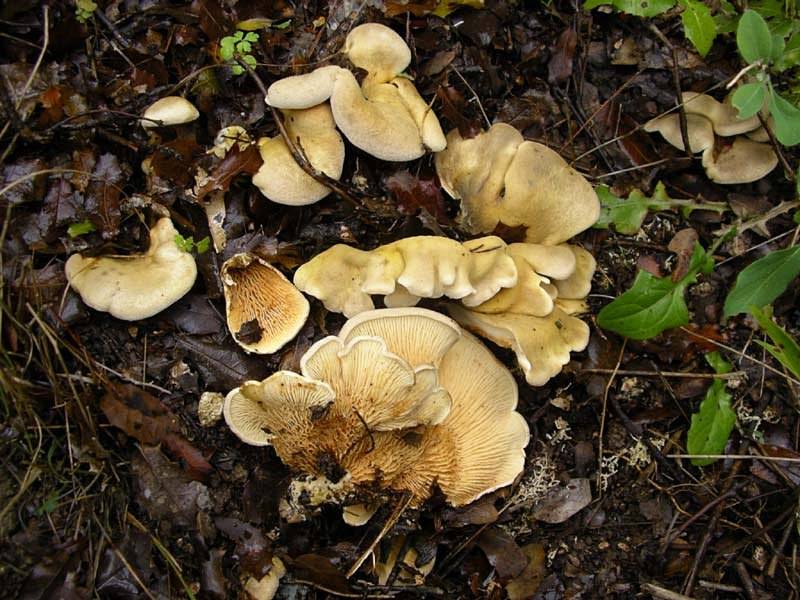




Most often there are two types of barn: thick, which is still eaten, and thin - dangerous to human health and life. It is imperative to distinguish between them. For this, photos can additionally help, they are even recommended to be taken with you to the forest and compared there on the spot.
Conditionally edible
The fat pig belongs to a group that is characterized by very low palatability, has no value as a source of useful ingredients. In foreign literature, it appears as inedible or with unexplored properties.



Distinctive features of a fat pig are a slow darkening of the cut, a short and thick velvet leg of a dark brown or black color, which has been compared to a cigar. The hat can reach 25 cm in diameter, velvety to the touch, brown or pistachio, with spots.
The hat can reach 25 cm in diameter, velvety to the touch, brown or pistachio, with spots.
Dangerous
The slender pig has a fleshy cap with curled edges and a funnel in the center. The color is olive, darkens with age.
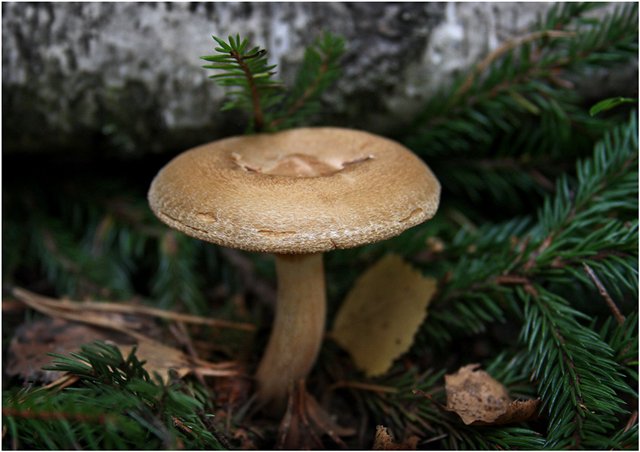


The size of the cap is usually in the range of 12-15 cm, it is very rare to find a 20-cm one. She herself is fleshy, thick. At a young age, it is light and dome-shaped, over time it changes shape to flat and even slightly curved towards the center, and the color darkens.
The range of colors is from light gray to rich olive. The edges of the cap are wavy, the surface is rough and fluffy, although if there is a lot of moisture around it, it becomes glossy, slippery and sticky.
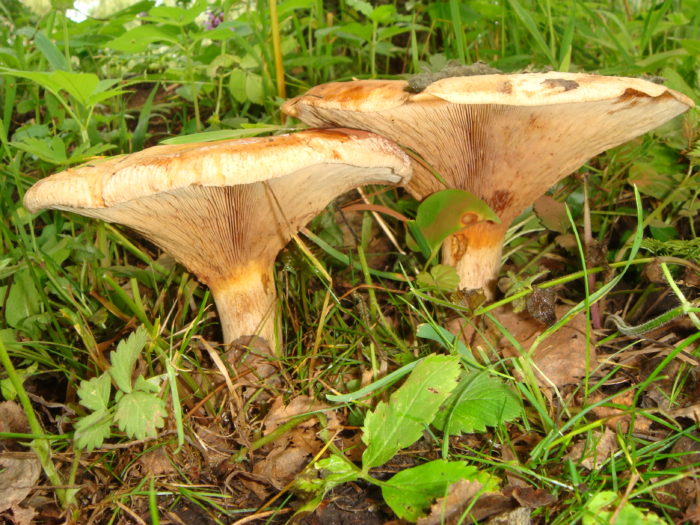 Cowshed
Cowshed
The leg is also medium-sized and even, it can reach a maximum of 9 cm in length and only 2 cm in width. The color is the same as the hat. A characteristic feature of the barn is that the flesh is light yellow inside, but on a break or cut it quickly darkens to brown.
The period and rules for collecting edible pigs
If mushroom pickers, despite not very flattering characteristics, still collect a barn, then you need to adhere to some rules:
go on a "quiet hunt" deep into the forest, moving as far as possible from highways and industrial buildings of factories - this will reduce the chances of collecting harmful chemicals for dinner;
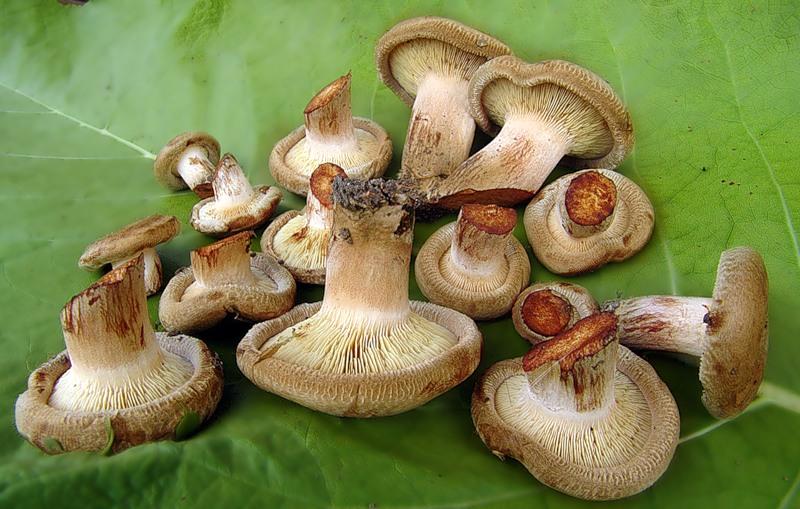 Pig collection
Pig collection
take only young fruiting bodies, the old ones accumulate more of these compounds over time;
do not eat large portions, mushrooms, in principle, are quite heavy food, they should play the role of a spicy addition on the plate, and not a main dish or side dish;
cook dunki, scrupulously observing all the rules: start cooking as early as possible, wash thoroughly, cook for a long time in several stages, draining the broth each time, do not store the finished dish for more than several hours.
The time for collecting the pig is the second half of summer and autumn.
Differences between a fat pig and a thin one and other poisonous mushrooms
The two most common pigs differ quite noticeably from each other in the rate of darkening of the pulp when broken and in the leg, namely in its color and thickness. It is convenient to compare it from the photo posted above. The cowsheds have no clear similarity with other poisonous mushrooms.
Inedible varieties
This family has poisonous species that it is better not to eat.
Olkhovaya
- Fruiting bodies can also be called aspen or alder pigs. It should be noted that this is a rather rare species. In appearance, such fruiting bodies strongly resemble thin pigs.
- However, the cap of the presented specimens has a cracking, scaly structure. Most often it is colored yellow-red. Grows mainly in deciduous forests under aspen and alder.
Thin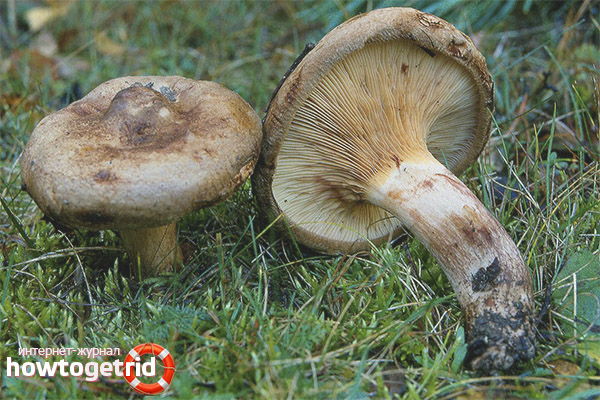
- It is distinguished by its thin hat, which grows up to 15 cm in size. In structure, the soft part is fleshy, compacted. Young growth is endowed with some bulges, turned up edges and a funnel at the top. The edges are wavy.
- The top is pigmented brownish-brownish-green in shade. But the color can be red and brown or brown and gray. When you press or cut the cap, a dark tone will appear. The top is dry, smoothed, but will become slippery and sticky when damp.
- The soft part is compacted, but loose in overripe specimens. It can change in color, becoming either brownish-yellow or brownish-yellow. If growth is carried out in dampness, worms start.
- Taste qualities with a smell are almost absent. The leg grows up to 9 cm in length and 2 cm in diameter. It is stained with dirty green pigment. It grows from early summer to autumn.
Ear-shaped
- Such fruiting bodies are distinguished by a lamellar structure and lateral attachment. The hat is in the shape of a cake and can reach a diameter of up to 17 cm. Mushrooms can grow singly or as an intergrown colony. The short stem originates from a thick mycelium.
- When the mushrooms are young, their cap has a felt surface. Over time, it becomes smooth. The color of the cap can be from cream to purple. The edge often curls downward. However, it is thin and wavy.
- On the bottom of the hat, you can see orange or yellowish plates. They are quite narrow. As for the base of the fruiting body, it is dense and velvety. In this case, the color is brown. The pulp is fleshy, after drying it acquires a spongy structure.
- As for the fruiting season, it begins in late summer and ends in late autumn. The fungus can grow in groups or singly. They are most often found on conifers and stumps.
The fat pig is edible. It has a rather unusual aroma and taste.
Special care must be taken when collecting
It is also important to have certain knowledge so as not to confuse it with poisonous brethren.

